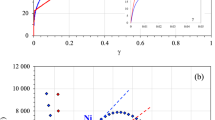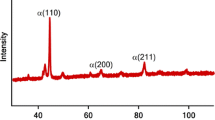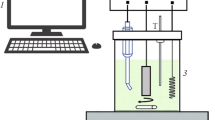Abstract
Understanding of and accounting for various mechanisms that affect inelastic deformation of crystalline metals in the presence of hydrogen remains an unsettled issue. Macroscopic experimental observations contradict limited atomistic simulations, complicating the situation. In this work, we extend a recent physically based crystal viscoplasticity framework to include constitutive equations with a direct dependence on relevant hydrogen and hydrogen-related defect concentrations. Focusing on initial yield and post-yield strain hardening, we consider hydrogen solute drag on mobile dislocations as well as the role of dilute concentrations of hydrogen-vacancy complexes as obstacles to dislocation motion. Furthermore, the evolution of hydrogen and hydrogen-affected defect concentrations is explicitly considered via evolving hydrogen trap concentrations. The resulting framework is used to investigate hydrogen effects on the quasistatic, monotonic, strain-controlled uniaxial loading of single-crystal stainless steel 316L smooth specimens at room temperature in an attempt to connect atomistic insight and the resulting mesoscale model framework with experimental interpretations. Attributing the primary role of hydrogen in this manner is shown to produce good agreement with experiments in the initial yield and post-yield regime. The dominance of various hydrogen effects mechanisms is discussed.










Similar content being viewed by others
References
W. Johnson, Nature, 1875, vol. 11, p. 393.
S.M. Myers, M. Baskes, H. Birnbaum, J.W. Corbett, G. DeLeo, S. Estreicher, E.E. Haller, P. Jena, N.M. Johnson, and R. Kirchheim, Reviews of Modern Physics, 1992, vol. 64, p. 559.
H. Barthélémy, International Journal of Hydrogen Energy, 2012, vol. 37, pp. 17364-17372.
R.P. Gangloff and B.P. Somerday: Gaseous Hydrogen Embrittlement of Materials in Energy Technologies: The Problem, Its Characterisation and Effects on Particular Alloy Classes. (Elsevier, 2012).
K. Popov and E. Nechai, Soviet Materials Science: a transl. of Fiziko-khimicheskaya Mekhanika Materialov/Academy of Sciences of the Ukrainian SSR, 1967, vol. 3, pp. 459-73.
I. Ghermaoui, A. Oudriss, A. Metsue, R. Milet, K. Madani, and X. Feaugas, Scientific Reports, 2019, vol. 9, pp. 1-10.
C. Beachem, Metallurgical and Materials Transactions B, 1972, vol. 3, pp. 441-455.
H.K. Birnbaum and P. Sofronis, Materials Science and Engineering: A, 1994, vol. 176, pp. 191-202.
S. Lynch, Scripta Metallurgica, 1979, vol. 13, pp. 1051-1056.
S. Lynch, Acta Metallurgica, 1988, vol. 36, pp. 2639-2661.
S. Lynch, Metallography, 1989, vol. 23, pp. 147-171.
N. Petch and P. Stables, Nature, 1952, vol. 169, pp. 842-843.
L.B. Pfeil, Proceedings of the Royal Society of London. Series A, Containing Papers of a Mathematical and Physical Character, 1926, vol. 112, pp. 182-95.
A. Troiano. General Keynote Lecture, Hydrogen in Metals. in Proc. Int. Conf. on the Effects of Hydrogen on Materials Properties and Selection and Structural Design, Champion, PA (September 23-27, 1973). 1973.
M. Nagumo, Materials Science and Technology, 2004, vol. 20, pp. 940-950.
M. Hatano, M. Fujinami, K. Arai, H. Fujii, and M. Nagumo, Acta Materialia, 2014, vol. 67, pp. 342-353.
A. Tehranchi and W.A. Curtin, Engineering Fracture Mechanics, 2019, vol. 216, p. 106502.
G.M. Castelluccio and D.L. McDowell, International Journal of Plasticity, 2017, vol. 98, pp. 1-26.
G.M. Castelluccio, C.B. Geller, and D.L. McDowell, International Journal of Plasticity, 2018, vol. 111, pp. 72-84.
G. Pressouyre, Metallurgical Transactions A, 1979, vol. 10, pp. 1571-1573.
W. Choo and J.Y. Lee, Metallurgical Transactions A, 1982, vol. 13, pp. 135-140.
H. Lee and J.-Y. Lee, Acta Metallurgica, 1984, vol. 32, pp. 131-136.
M. Louthan Jr, G. Caskey Jr, J. Donovan, and D. Rawl Jr, Materials Science and Engineering, 1972, vol. 10, pp. 357-368.
J.Y. Lee and S. Lee, Surface and Coatings Technology, 1986, vol. 28, pp. 301-314.
D. Connétable, Y. Wang, and D. Tanguy, Journal of Alloys and Compounds, 2014, vol. 614, pp. 211-220.
A.H. Cottrell and B. Bilby: Proceedings of the Physical Society. Section A, 1949, vol. 62, p. 49.
M. Wen, S. Fukuyama, and K. Yokogawa, Physical Review B, 2004, vol. 69, p. 174108.
J.E. Angelo, N.R. Moody, and M.I. Baskes, Modelling and Simulation in Materials Science and Engineering, 1995, vol. 3, p. 289.
D. Tanguy, Y. Wang, and D. Connétable, Acta Materialia, 2014, vol. 78, pp. 135-143.
S. Myers, P. Nordlander, F. Besenbacher, and J. No, Physical Review B, 1986, vol. 33, p. 854.
Y. Yagodzinskyy, M. Ivanchenko, and H. Hänninen. Hydrogen-Dislocation Interaction in Austenitic Stainless Steel Studied with Mechanical Loss Spectroscopy. in Solid State Phenomena. 2012. Trans Tech Publ.
S. Karpov, G. Tolstolutskaya, B. Sungurov, and V. Ruzhytskiy, Boпpocы Aтoмнoй нayки и Mexники, 2017, vol. 2, pp. 36-40.
H. Mughrabi, Acta Metallurgica, 1983, vol. 31, pp. 1367-1379.
L. Chen, X. Xiong, X. Tao, Y. Su, and L. Qiao, Corrosion Science, 2020, vol. 166, p. 108428.
N. Hansen, X. Huang, and D. Hughes, Materials Science and Engineering: A, 2001, vol. 317, pp. 3-11.
J. Angelo, N. Moody, and M. Baskes, In Hydrogen Effects in Materials, (Trans. Met. Soc. AIME New York, NY: 1996), pp 161-70.
A. Cottrell. Effect of Solute Atoms on the Behavior of Dislocations. in Report of a Conference on Strength of Solids. 1948. The Physical Society London.
J. Hirth and J. Lothe: Theory of Dislocations. 2nd ed. (Wiley, New York, 1982).
Y. Wang, D. Connétable, and D. Tanguy, Physical Review B, 2015, vol. 91, p. 094106.
P. Hautojarvi, H. Huomo, P. Saariaho, A. Vehanen, and J. Yli-Kauppila, Journal of Physics F: Metal Physics, 1983, vol. 13, p. 1415.
S. Linderoth, H. Rajainmäki, and R. Nieminen, Physical Review B, 1987, vol. 35, p. 5524.
R. Kirchheim, Scripta Materialia, 2012, vol. 67, pp. 767-770.
Y. Tateyama and T. Ohno, Physical Review B, 2003, vol. 67, p. 174105.
O.Y. Vekilova, D. Bazhanov, S. Simak, and I. Abrikosov, Physical Review B, 2009, vol. 80, p. 024101.
Y. Fukai, Y. Shizuku, and Y. Kurokawa, Journal of Alloys and Compounds, 2001, vol. 329, pp. 195-201.
Y. Fukai, Physica Scripta, 2003, vol. 2003, p. 11.
M. Nagumo, ISIJ International, 2001, vol. 41, pp. 590-598.
T. Matsuo, J. Yamabe, and S. Matsuoka, International Journal of Hydrogen Energy, 2014, vol. 39, pp. 3542-3551.
A. Cuitino and M. Ortiz, Acta Materialia, 1996, vol. 44, pp. 427-436.
J. Polák and M. Sauzay, Materials Science and Engineering: A, 2009, vol. 500, pp. 122-129.
D. Xie, S. Li, M. Li, Z. Wang, P. Gumbsch, J. Sun, E. Ma, J. Li, and Z. Shan, Nature Communications, 2016, vol. 7, pp. 1-7.
Y. Zhu, Z. Li, M. Huang, and H. Fan, International Journal of Plasticity, 2017, vol. 92, pp. 31-44.
D. Chen, L.L. Costello, C.B. Geller, T. Zhu, and D.L. McDowell, Acta Materialia, 2019, vol. 168, pp. 436-447.
M.L. Dos Reis, L. Proville, and M. Sauzay, Physical Review Materials, 2018, vol. 2, p. 093604.
H. Neuhäuser, Physica Scripta, 1993, vol. 1993, p. 412.
D. Caillard and J. Martin: Thermally Activated Mechanisms in Crystal Plasticity. (Pergamon, Oxford, 2003).
A. Argon: Strengthening Mechanisms in Crystal Plasticity. (Oxford University Press on Demand, 2008).
A. Tehranchi, B. Yin, and W. Curtin, Philosophical Magazine, 2017, vol. 97, pp. 400-418.
G. Hachet, A. Metsue, A. Oudriss, and X. Feaugas, Int. J. Plastic., 2020, vol. 129, p. 102667.
R.L. Fleischer, Acta Metallurgica, 1963, vol. 11, pp. 203-209.
J. Friedel: Disocations. (Pergamon Press, 1964).
R. Labusch, Physica Status Solidi (b), 1970, vol. 41, pp. 659-669.
A.H. Cottrell and M. Jaswon, Proceedings of the Royal Society of London. Series A. Mathematical and Physical Sciences, 1949, vol. 199, pp. 104-114.
A.H. Cottrell: Dislocations and Plastic Flow in Crystals. (Clarendon Press, Oxford, 1953).
W. James and D. Barnett, Solute-Defect Interaction. Theory and Experiment, pp. 136-142. (Pergamon, Oxford, 1985).
R. Sills and W. Cai, Philosophical Magazine, 2016, vol. 96, pp. 895-921.
Y. Li, T. Morgan, D. Terentyev, S. Ryelandt, A. Favache, S.-C. Wang, M. Wirtz, J. Hoefnagels, J. van Dommelen, and G. De Temmerman, Nuclear Fusion, 2020, vol. 60, p. 086015.
B. Wilcox and R. Huggins, Journal of the Less Common Metals, 1960, vol. 2, pp. 292-303.
J. Song and W. Curtin, Acta Materialia, 2014, vol. 68, pp. 61-69.
G. Girardin and D. Delafosse, Scripta Materialia, 2004, vol. 51, pp. 1177-1181.
U.F. Kocks, A. A. S., and A. M. F., Progress in Materials Science, 1975, vol. 19.
J. Polák and J. Man, Materials Science and Engineering: A, 2014, vol. 596, pp. 15-24.
K. Differt and U. Essmann, In Fundamental Aspects of Dislocation Interactions, (Elsevier, New York, 1993), pp 295-299.
U. Essmann and H. Mughrabi, Philosophical Magazine A, 1979, vol. 40, pp. 731-756.
U. Essmann, U. Gösele, and H. Mughrabi, Philosophical Magazine A, 1981, vol. 44, pp. 405-426.
K.M. Davoudi and J.J. Vlassak, Journal of Applied Physics, 2018, vol. 123, p. 085302.
E. Schafler, G. Steiner, E. Korznikova, M. Kerber, and M. Zehetbauer, Materials Science and Engineering: A, 2005, vol. 410, pp. 169-173.
T. Ungár. Subgrain Size-Distributions, Dislocation Structures, Stacking-and Twin Faults and Vacancy Concentrations in Spd Materials Determined by X-Ray Line Profile Analysis. in Materials Science Forum. 2006. Trans Tech Publ.
S. Xu, L. Xiong, Y. Chen, and D.L. McDowell, Journal of the Mechanics and Physics of Solids, 2016, vol. 96, pp. 460-476.
R.A. Oriani, Acta Metallurgica, 1970, vol. 18, pp. 147-157.
P. Sofronis and R.M. McMeeking, Journal of the Mechanics and Physics of Solids, 1989, vol. 37, pp. 317-350.
J. Tien, A.W. Thompson, I. Bernstein, and R.J. Richards, Metallurgical Transactions A, 1976, vol. 7, pp. 821-829.
M. Dadfarnia, M.L. Martin, A. Nagao, P. Sofronis, and I.M. Robertson, Journal of the Mechanics and Physics of Solids, 2015, vol. 78, pp. 511-525.
Y. Liang, D. Ahn, P. Sofronis, R. Dodds Jr, and D. Bammann, Mechanics of Materials, 2008, vol. 40, pp. 115-132.
H. Zheng, B. Rao, S. Khanna, and P. Jena, Physical Review B, 1997, vol. 55, p. 4174.
E.N. Epperly and R.B. Sills, Acta Materialia, 2020, vol. 193, pp. 182-190.
D. Ulmer and C. Altstetter, Acta Metallurgica et Materialia, 1993, vol. 41, pp. 2235-2241.
C. San Marchi, B.P. Somerday, and S.L. Robinson, Int. J. Hydrog. Energy, 2007, vol. 32, pp. 100116.
R. Cahn and P. Haasen: Physical Metallurgy. (North-Holland, Oxford, 1996).
L.P. Kubin, Materials Science and Technology, 1993, vol. 6, pp. 137-190.
S. Patinet and L. Proville, Physical Review B, 2008, vol. 78, p. 104109.
H. Stehle and A. Seeger, Zeitschrift für Physik, 1956, vol. 146, pp. 217-241.
G. Abaqus, Dassault Systemes Simulia Corp Providence, RI, 2011.
Y. Yagodzinskyy, T. Saukkonen, S. Kilpeläinen, F. Tuomisto, and H. Hänninen, Scripta Materialia, 2010, vol. 62, pp. 155-158.
A.-M. Brass and J. Chêne, Corrosion Science, 2006, vol. 48, pp. 3222-3242.
G. Love, Acta Metallurgica, 1964, vol. 12, pp. 731-737.
P. Ferreira, I. Robertson, and H. Birnbaum, Acta Materialia, 1998, vol. 46, pp. 1749-1757.
P. Sofronis and I. Robertson, Philosophical Magazine A, 2002, vol. 82, pp. 3405-3413.
W.G. Johnston, Journal of Applied Physics, 1962, vol. 33, pp. 2716-2730.
D. Psiachos, T. Hammerschmidt, and R. Drautz, Acta Materialia, 2011, vol. 59, pp. 4255-4263.
H.M. Ledbetter and R.P. Reed, Journal of Physical and Chemical Reference Data, 1973, vol. 2, pp. 531-618.
S. Lawrence, B. Somerday, and R. Karnesky, JOM, 2017, vol. 69, pp. 45-50.
G. Hachet, A. Metsue, A. Oudriss, and X. Feaugas, Acta Materialia, 2018, vol. 148, pp. 280-288.
R. Kirchheim, Acta Materialia, 2007, vol. 55, pp. 5139-5148.
A. Barnoush and H. Vehoff, Acta Materialia, 2010, vol. 58, pp. 5274-5285.
A. Barnoush, M. Asgari, and R. Johnsen, Scripta Materialia, 2012, vol. 66, pp. 414-417.
K. Miyata, Metallurgical and Materials Transactions A, 2003, vol. 34, pp. 1249-1257.
S.K. Lawrence, B.P. Somerday, M.D. Ingraham, and D.F. Bahr, JOM, 2018, vol. 70, pp. 1068-1073.
A. Cottrell, Philosophical Magazine, 2006, vol. 86, pp. 3811-3817.
J.D. Eshelby, Proceedings of the Royal Society of London. Series A. Mathematical and Physical Sciences, 1957, vol. 241, pp. 376-96.
T. Mura: Micromechanics of Defects in Solids. (Springer Science & Business Media, Berlin, 2013).
M. Sauzay and L.P. Kubin, Progress in Materials Science, 2011, vol. 56, pp. 725-784.
D. Kuhlmann-Wilsdorf, Trans. Met. Soc., 1962, vol. 224, p. 962.
Y. Estrin, L. Toth, A. Molinari, and Y. Bréchet, Acta Materialia, 1998, vol. 46, pp. 5509-5522.
A. Arsenlis and D.M. Parks, Journal of the Mechanics and Physics of Solids, 2002, vol. 50, pp. 1979-2009.
A. Patra and D.L. McDowell, Philosophical Magazine, 2012, vol. 92, pp. 861-887.
L.P. Kubin, G. Canova, M. Condat, B. Devincre, V. Pontikis, and Y. Bréchet, Solid State Phenomena, 1992, vol. 23-24, pp. 455-472.
A. Ma and F. Roters, Acta Materialia, 2004, vol. 52, pp. 3603-3612.
X. Feaugas, Acta Materialia, 1999, vol. 47, pp. 3617-3632.
Acknowledgments
We acknowledge the financial support of the Fluor Marine Propulsion, LLC, particularly discussions with Drs. Clint Geller and Benjamin Anglin.
Author information
Authors and Affiliations
Corresponding author
Additional information
Publisher's Note
Springer Nature remains neutral with regard to jurisdictional claims in published maps and institutional affiliations.
Manuscript submitted on January 25, 2021; accepted June 14, 2021.
Appendices
Appendix A
The activation energy, \( \Delta G \), associated with dominant short-range barriers to thermally assisted dislocation motion, is expressed as
where \( F_{0} \) is the activation energy, and \( p \) and \( q \) are profiling parameters. Parameter \( s_{t}^{0} \) is the athermal limit of thermal slip resistance at 0 K, and \( \mu \) and \( \mu_{0} \) are the shear modulus at temperature \( T \) and 0 K, respectively. This relation must reflect the statistical distribution of barriers at the mesoscale via \( F_{0} \) and profile parameters \( p \) and \( q \).
The threshold stress that considers strengthening mechanisms active in the absence of hydrogen, \( S^{\alpha } \), accounts for the intrinsic lattice friction, the stress required to bow-out a dislocation, and the dislocation-dislocation self-interactions that result from collinear dislocations in pile-ups. The overall contribution of these three mechanisms can be expressed additively as
where \( \alpha_{LE} \) is the dislocation line energy, \( f_{w} \) is the volume fraction of dislocation wall substructures, and \( d_{struct} \) is the characteristic dimension of dislocation wall substructures. Intrinsic lattice friction \( S_{0}^{\alpha } \) is quite small for FCC systems, about 4 MPa in this case, and is dominated by the short range barriers associated with thermal slip resistance \( s_{t}^{0} \).
The back stress accounts for the directional internal stress developed due to heterogeneity of plastic deformation within dislocation substructures, ensuring the largely plastic strain in dislocation channels maintains compatibility with the largely elastic strain in dislocation substructure walls. The back stress superimposes on the applied resolved shear stress to form the effective directional over stress. Assuming an Eshelby-type inclusion formulation,[110] the back stress rate can be expressed as
where \( f_{Hill}^{s} \) is the instantaneous macroscopic plastic deformation tangent and \( S_{1212} \) is a component of the Eshelby tensor component.[111]
Determination of the dislocation substructure parameters relies on experimentally observed similitude characteristics. Following previous works,[112,113] the characteristic dislocation substructure length scale is determined via
where \( K_{struct} \) is the constant of similitude and the max function in the denominator returns the maximum slip system level resolved shear stress in the volume of interest.
The mean free path for dislocation glide is evaluated as
where \( \eta \) is a parameter determining the aspect ratio of dislocation substructures. For example, \( \eta = 1 \) corresponds to dislocation cells while \( \eta = 50 \) corresponds to more elongated substructures such as dislocation veins. For cyclic loading, \( \eta \) is determined by evaluating cyclic plastic strain ranges. In the current study, where specific focus is placed on monotonic loading, this value is assigned a constant value.
The last dislocation substructure parameter to be described is the volume fraction of dislocation dense substructure walls. Here, a phenomenological relationship is leveraged from prior work[114] to define the dislocation substructure wall volume fraction, i.e.,
where \( f_{inf} \), \( f_{0} \), and \( g_{p} \) are constants that can be estimated by careful substructure characterization using tools such as transmission electron microscopy. Lastly, \( \gamma^{max} \) is the maximum shear strain over all slip systems.
The mobile screw dislocation density evolution on slip system \( \alpha \) is a result of the competition between dislocation multiplication, annihilation, and cross-slip. Following prior work,[115,116] the overall expression for the dislocation density evolution can be written as
The multiplication rate is defined as
where \( k_{multi} \) is a constant that depends on the type of expected substructure. The annihilation rate for monotonic loading is defined as
where \( y_{s}^{edge} \) is the annihilation distance for edge dislocations. A second annihilation term formulated by Castelluccio and McDowell[18] to account for anelastic dislocation annihilation upon unloading is dropped in Eq. [A9] as focused is placed on monotonic loading.
The cross-slip term follows a probabilistic formulation from previous work,[117] but considers a local shear stress that accounts for dislocation substructure shielding, i.e.,
where \( v_{G}^{cs} \), \( \tau_{III} \), \( \varphi_{cs} \), and \( V_{cs} \) are the characteristic cross-slip frequency, critical cross-slip stress at the onset of stage III hardening, cross-slip efficiency, and cross-slip activation volume, respectively. Indices \( \zeta \) and \( \alpha \) denote collinear slip systems that permit cross-slip. To account for wall dislocations for hydrogen trapping, we make a simple extension to the MS-CP model and assume \( \rho_{i}^{\alpha } = 150\rho_{m}^{\alpha } \). This simple relation is justified for simple loading scenarios as the dislocation density in walls tracks with the mobile dislocation density[118] and the chosen pre-factor generates reasonable wall dislocation densities observed experimentally.[119]
A brief outline of the constitutive equations has been provided. The values used for SS316L are provided in Table A1 with complete details on the MS-CP model found in the original paper.[18]
Appendix B
The functional forms for the values used in Eq. [13] are expressed as[66]
where the variables in these equations are defined in Section III.
Rights and permissions
About this article
Cite this article
Zirkle, T., Costello, L. & McDowell, D.L. Crystal Plasticity Modeling of Hydrogen and Hydrogen-Related Defects in Initial Yield and Plastic Flow of Single-Crystal Stainless Steel 316L. Metall Mater Trans A 52, 3961–3977 (2021). https://doi.org/10.1007/s11661-021-06357-8
Received:
Accepted:
Published:
Issue Date:
DOI: https://doi.org/10.1007/s11661-021-06357-8




